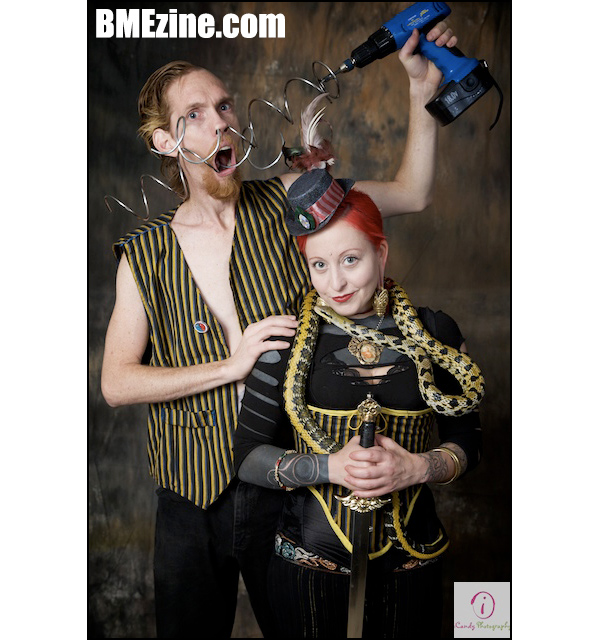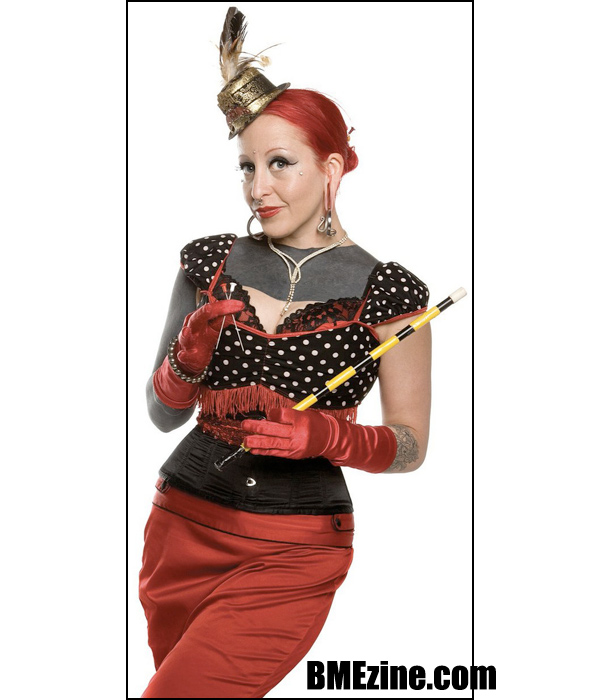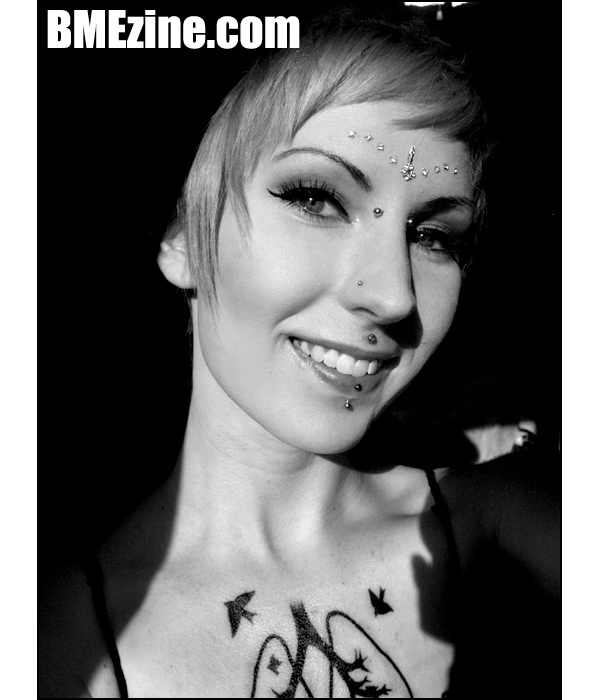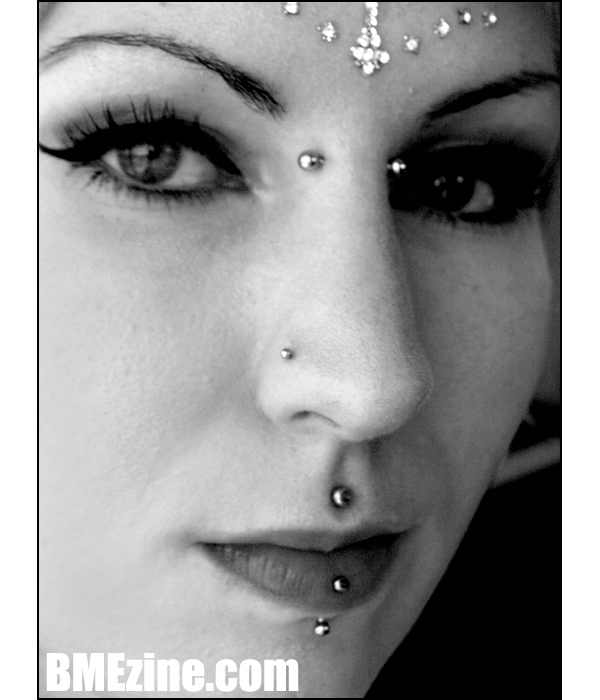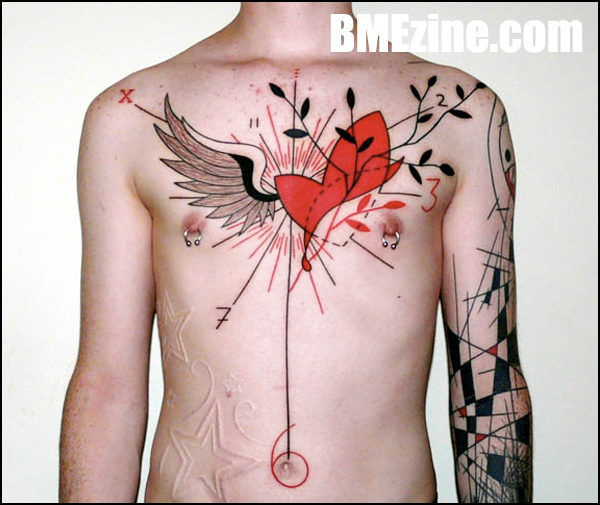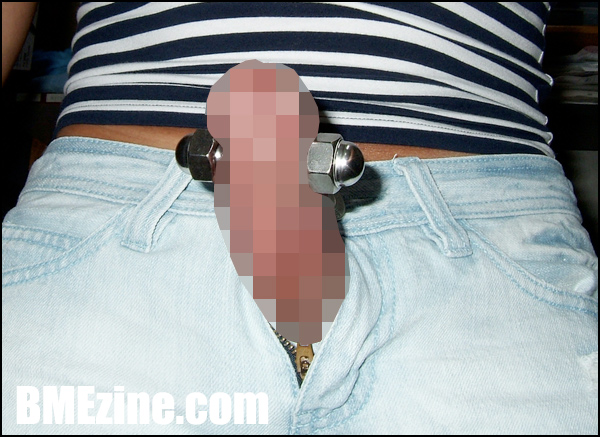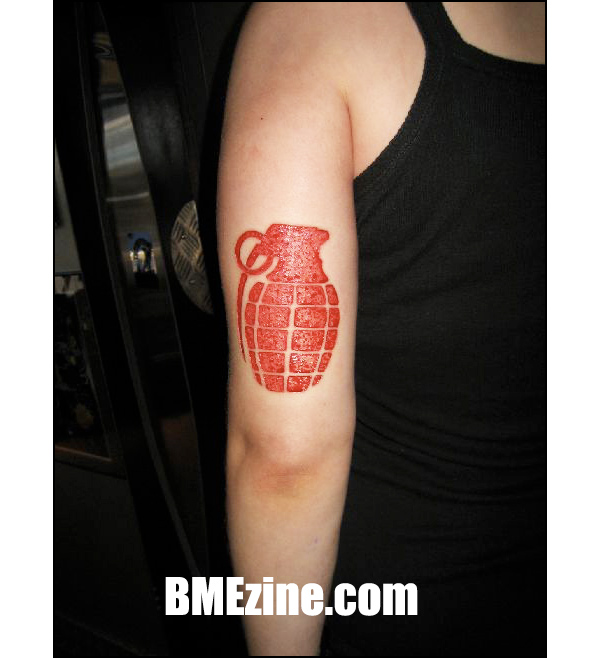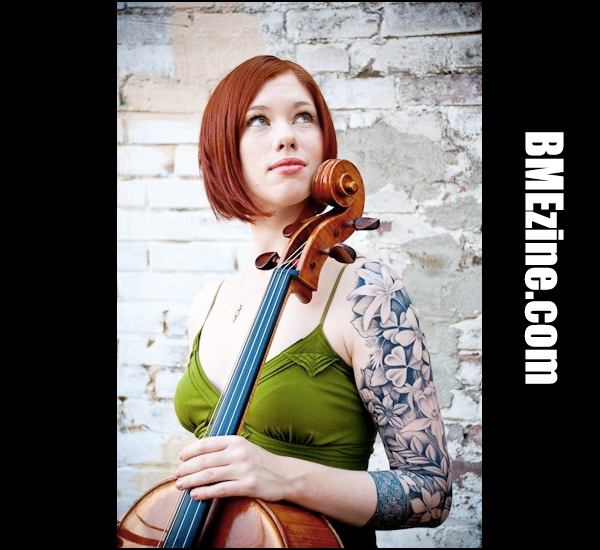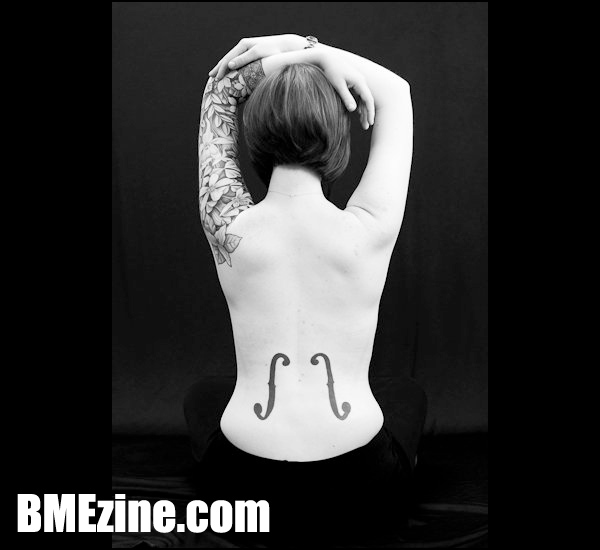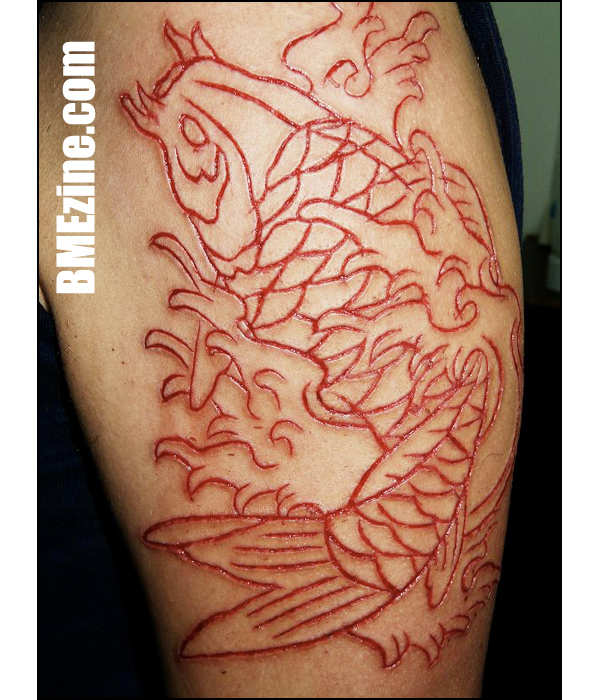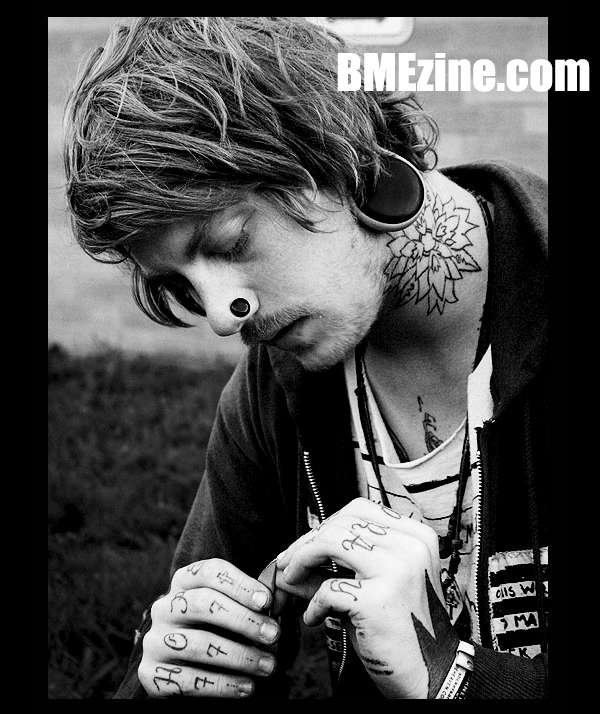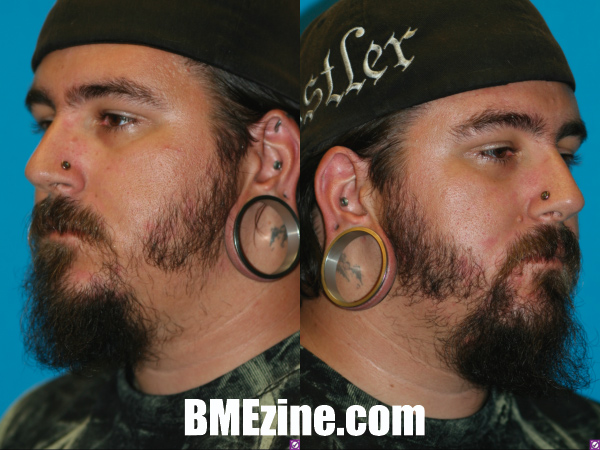
A little while ago, we got an e-mail from a man named David Kitts. Having been around the body modification community for about a decade, he’d stretched his lobes to two inches, but recently underwent surgery to reconstruct them to their original state—the idea and process of which has left him conflicted at best. He felt like his story could be useful as a cautionary of sorts, and so we spoke to him. In our interview, he discusses why he went the surgery route, what the procedure itself entailed, the effects it’s had on him mentally and more—after the jump.
BME: First off, just for some background, what do you do for a living?
David Kitts: Well, I’ve been in and out of piercing and performing some of the heavier mods for about eight years now, working straight jobs when I couldn’t afford to work at shops. I have been, for several months, working for myself rehabbing old bikes, mopeds and motorcycles, and just got a decent job at a large-box sporting goods store.
BME: So, at what point did you realize body modification was going to be an important part of your life?
DK: When I was about 16, I heard about a local 4:20 shop in Lexington, South Carolina, that also had a piercing shop. I started hanging out mainly because of my parents’ hatred of piercings, and I read a book they had there—I can’t remember the name, but it did have a “pierced” cover with a large CBR—and was fascinated. (This was back in 1999-2000, before it really became fashionable to have “belly” rings and all that.) The day after my birthday, I got my ears pierced at 10 gauge and bought a set of eight gauges for when I could go up. There was a guy there named Lonnie who had a ton of facial piercings and a set of early monster CBRs that were a half-inch and 10.3 ounces each; I have them now. I loved the way it looked, and the impermanence of it was kinda nice. It didn’t hurt for as long as a tattoo did, but it still made the wearer, for the most part, beautiful.
Since then, I’ve had 257 piercings (I’ve kept track), including cheeks, three bridge, eight nape (that were 1.5-inches long point-to-point) and 1.25-inch-long surface bars vertically in the back of my arms, three each side. Also, the one that freaked the piercer out was a two-inch-long, 10-gauge madison done with Tygon.
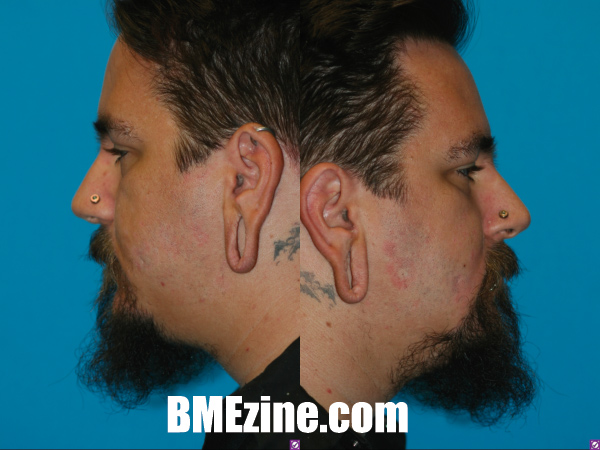
BME: Now, the photos you sent in recently showed your ears post-surgery after having your two-inch lobes closed up. First of all, how long did it take you to get your lobes to that size?
DK: I got to one inch in a bit under two years. I got stuck for a while, because of jobs and lack of jewelry, but one day I tried to shove something in that was bigger and they went fast as hell after that. I went from a little bigger than a Coke cap to two inches in six months. My ears stretched on their own, probably because I played with them (unconsciously) during the day and slept with the earrings in. In fact, the large tunnels I had that were my “goal,” I wore for a week before they fell out.
BME: How long ago did you get your lobes up to that size?
DK: About eight, months or so. I got to two inches and was happy as hell; that was a “size goal,” as it were. I was already heading past it when I had surgery.
BME: It sounds like this was something into which you’d put some effort and of which you were proud, but we’re talking today because you’ve since had your lobes reconstructed. What led to this?
DK: Well, regarding that “goal” of two inches, I said that I’d consider getting them put back to “normal” after. So, when I got there, ironically, I was introduced to one of Charleston’s top plastic surgeons. We got to talking and he agreed to do the work, way before I realized what exactly I was doing, but I had a few months to decide whether or not to go through with the surgery due to schedule conflicts, so no big deal.
I had been out of a “real” job since December, and no one would hire me because of the piercings. The tattoos on my hands and arms were fine, the bats on my neck were OK, even my stretched nostrils were passable, but not the ears. And hey, I’m almost 27, so I sat down one night and went over everything: How I felt about how I looked versus “mainstream” people, and the future. This was a chance that I couldn’t pass up—having my lobes redone, that is—but I didn’t know if I could live with myself if I did. I felt like I’d be giving in. I’ve always been a fighter for individuality. I tried to make sure I stood up for people who expressed themselves differently, be they transgendered or just heavily tattooed, I didn’t care—it’s a choice. I just happened to go a little more into the deep end, as it were.
So, for about three weeks, I struggled with whether or not I would be OK with myself afterward, if my friends would be, and what would happen. For all I knew, I could do all this and never get another real job and be severely pissed because of it. But, I figured I could always redo the ears if time allowed, and that I’d be an idiot to not give the surgery a chance. So I went for it. It’s been hard dealing with day-to-day things now. Harder than I expected.
BME: Just to backtrack for a minute, you said that beforehand, you considered shrinking your ears back down to “normal” once you reached two inches. By “normal,” do you mean a smaller diameter, or closed up as they are now? And what was the motivation to reach two inches if you had already decided it could just be a temporary thing?
DK: I was referring to getting surgery when I got to two inches. I knew it’d take a while to let them shrink, and I think I was well past being able to go back to something “socially acceptable.” I wanted them forever—it wasn’t a temporary decision. When I got to two inches (I figured it’d be quite a while), I’d evaluate my life and see if anything needed to be done. If life was good, I’d keep them. If not, I’d figure something out—either let them shrink as much as they’d go, or surgery. Basically, I’d get to two inches and see where the lobes fit into my life and deal with them accordingly.
BME: Got it. So obviously, they were interfering in a way that was complicating your life. How did you end up meeting the surgeon who did the procedure? Had he done that specific kind of work before?
DK: A friend of mine introduced us at some function; we got to talking about it and he said he’d be willing. Not too sure if he had done this specifically, but he had mentioned he’d worked on some people who had ripped lobes (like little old ladies). But, he provided me a good service. He’s strictly a facial surgeon—he does a lot of charity work for children with cleft palates, making them more “normal” and all. He works from the neck up, and there’s another doctor in the office that works from the neck down.
BME: Was it an expensive procedure?
DK: It cost me $1,300, and I got a good deal.

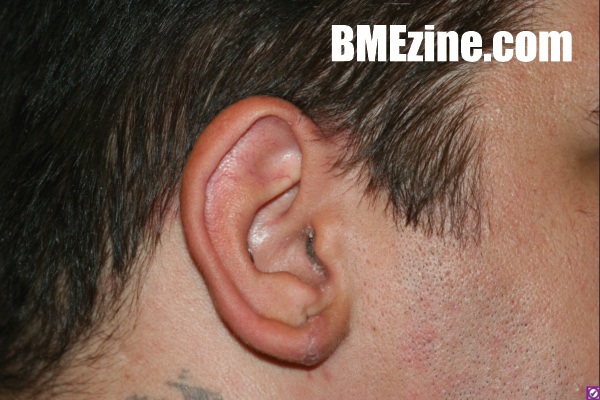
BME: What did the procedure entail?
DK: Well, at least one week before, he wanted me to take the jewelry out so that the lobes could relax some. (I didn’t label them like I wanted, but in those pictures, the ones where my lobes look all fat are the day of, right before surgery.) When I went in, pictures were taken and I was led to a “recovery suite” to wait. When we finally went up to the O.R., it was all very quick. After being covered and cleaned, he injected a shot of local anesthetic in each lobe that had a vascular constrictor in it to slow blood flow. I couldn’t feel anything past that.
He started by taking surgical scissors to the right lobe and just cut 80 percent off. I may have had about a quarter inch on each side left. He had to cauterize the right lobe because the constrictor wasn’t fully effective yet, but the pain killer was (thankfully). After some measuring, he trimmed the ends a bit (where he already cut) and skinned my inner lobe into an upside-down “U” to remove the skin that used to sit on the saddle of the jewelry. That was done so that when he sewed me up, there wouldn’t be any little holes where healed skin was left. He repeated the same steps for the left side, but the skin in the front of my lobe near the tragus was thinner than the right lobe, so it went faster with a lot less trimming needed. I think it’s the more normal-looking of the two.
After all was cut, he sewed me mostly with dissolving stitches—about eight in each ear, I think he said. He did add one stitch from my lobe to my neck to promote them healing “down,” and he forgot to test the area on my neck to see if it was numb before that. It wasn’t numb, but the pain wasn’t bad. Afterwards, beyond NeoSporin, there were no special instructions. They healed almost completely in a week, and I went to the beach in a week and a half. And thats it! Fun. The weirdest part was being awake the whole time and hearing the scissors cutting. It sounded like cardboard.
BME: That seems pretty straightforward. And how long ago did you have it done?
DK: Two weeks ago, and I got hired to a good position at a sporting goods store after putting in two applications on Thursday of last week. So yeah, I’d say it worked.
BME: So you feel comfortable attributing that quick turnaround to the surgery, then?
DK: Oh, yeah. I asked about a job before and the manager rejected me and told me why. Then I came back after the surgery and he said he wanted me to work there now that my lobes were back to normal.
BME: But even still, you say it’s been hard to deal with.
DK: Yeah. More personally than anything.
BME: How so?
DK: Well, for years I’d had these stretched ears. I always got the, “Did that hurt?” question, and had come-backs for just about anything people could throw at me. I also had a reason when people stared at me. I knew why, but when I went out without the lobes, people still stared, and it felt like I lost my shield. I felt defenseless, and it scared me. I still feel the same way, and it bothers me now more than ever when people give me weird looks. It used to be easily written off—now, not so much. And when I look in the mirror, I’m not happy. It looks like a fake me, like someone else, and it really bugs me. It was such a big part of my life, now that they’re gone it really bothers me. I’ve lost a few friends too, and now I have to go through explaining to everyone that knew me before why I did this. And I still get asked if it fucking hurt.
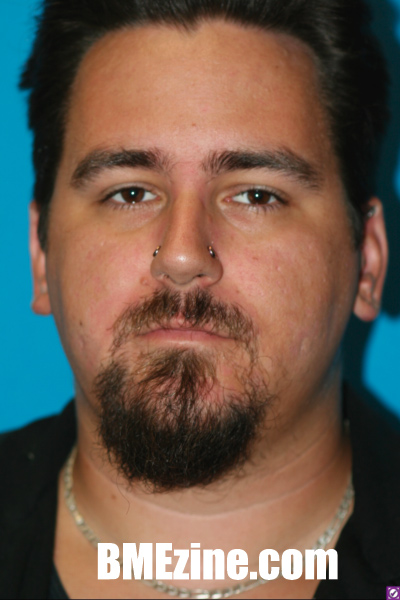
BME: Without getting too Dr. Phil about this, why on earth would you lose friends over something like this? That seems ridiculous.
DK: I know. But to them, they viewed me as a sellout. In one’s words, I “turned my back on them,” which is B.S., but whatever.
BME: B.S. indeed. Before the surgery, did you expect your personal adjustment would have been easier than it has been?
DK: Yeah. I figured I’d miss the “old me,” but I didn’t think it would be anything like it is now. You know the biggest insult I’ve gotten so far? “You look so much better now!”
BME: So, between not quite feeling like yourself minus your stretched lobes and having others call you a “sellout,” what do you think? Do you consider yourself a sellout or anything like that?
DK: A tiny bit, yes, because I don’t think I should have to change for a job. I’m still as good an employee with the lobes, and I feel that I, and everyone else, should be accepted for who we are. It’s not like I got all this shit done to not get a job, you know? I just wanted to be beautiful, the way I saw it. I could still sell stuff or do any number of jobs, but because of the way I looked, I was prejudged as a “bad person” and unemployable. There are only so many Hot Topics in an area, and working as a bouncer kinda sucks. But I am doing what’s best for me and my future now that I’m a little bit older and wiser.
BME: Knowing what you do now and how things have turned out, do you regret stretching your lobes that big in the first place?
DK: Not at all. The friends I’ve made, the conversations that have been started with them—hell, I even won a trip to see the Jerry Springer show because of them. I hope to have opened some people’s eyes to this type of modification. I’ve spoken at some schools on the right way to get pierced, and the importance of waiting (pre-surgery) and plan on doing the same after. My ears did get me a job at a few haunted houses. Imagine a 250-pound, six-foot-tall tall guy with running chain-saws attached to his lobes running at you.
I will continue to advocate modifying yourself as you see fit, so long as it is in a safe environment. And I will still get modified in other ways. There’s plenty left for me to do, and now I can say I’m an amputee of sorts—I nullo’d my lobes [laughs].
BME: Before we wrap up, anything you’d like to add?
DK: Sure. The main reason I came to you to put this out there is because I know there are a lot of young readers on BME, and this experience is for them. People like Allen Falkner and Erik Sprague don’t need to hear this, but the ones that go on ModBlog and who do see the glory and beauty in modification, there can be a harsh reality that, if you don’t plan on it, can come back and bite you in the ass. I just want people thinking about doing this to know there are consequences, but I don’t want to divert anyone—I just want to show both sides. I wouldn’t change anything I’ve done at all. I loved my lobes when I had them, and I miss them and am dealing with the emotions without them now, but I stand by my choices.
Tattoo Hollywood, BME’s first tattoo convention, is coming to Los Angeles from August 21-23, featuring contests, prizes and some of the best artists from around the world! Click here for more information.
